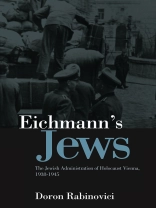The question of the collaboration of Jews with the Nazi regime
during the persecution and extermination of European Jewry is one
of the most difficult and sensitive issues surrounding the
Holocaust. How could people be forced to cooperate in their own
destruction? Why would they help the Nazi authorities round up
their own people for deportation, manage the ‘collection points’
and supervise the people being deported until the last moment?
This book is a major new study of the role of the Jews, and more
specifically the ‘Judenrat’ or Jewish Council, in Holocaust Vienna.
It was in Vienna that Eichmann developed and tested his model for a
Nazi Jewish policy from 1938 onwards, and the leaders of the
Viennese Jewish community were the prototypes for all subsequent
Jewish councils. By studying the situation in Vienna, it is
possible to gain a unique insight into the way that the Nazi regime
incorporated the Jewish community into its machinery of
destruction.
Drawing on recently discovered archives and extensive
interviews, Doron Rabinovici explores in detail the actions of
individual Jews and Jewish organizations and shows how all of their
strategies to protect themselves and others were ultimately doomed
to failure. His rich and insightful account enables us to
understand in a new way the terrible reality of the victims’
plight: faced with the stark choice of death or cooperation, many
chose to cooperate with the authorities in the hope that their
actions might turn out to be the lesser evil.
Tabla de materias
Preface.
1 Prologue.
Survivor guilt.
Breaching taboos.
No mass murder without victims.
2 The Vienna Kultusgemeinde before 1938.
Securing evidence – at the scene of the crime.
Jewish strategies to counter anti-Semitism.
The corporate state – in the shadow of the Third Reich.
3 Persecution.
The German invasion and the Austrian response.
Expropriation through the deprivation of rights.
The hunt for booty.
4 Struggle for survival and escape.
The decapitation of the Jewish Community.
The attempt to escape or ‘Get rid of the Yids and keep their
money here.’
5 The Vienna Jewish community under Nazi control.
The reorganization of the Kultusgemeinde.
Jewish self-help and welfare.
‘Emigration’ – mass expulsion.
Illegal escape.
6 November pogrom – overture to murder.
7 The Jewish community after the pogrom.
Escape as a last resort.
Functionaries: victims and messengers of terror.
Administration during the terror.
Benjamin Murmelstein.
The employees in the system.
Lateral entrants.
8 Beginning of the end.
Nisko or the dress rehearsal for deportation.
Segregation, concentration and theft.
9 Deportation and extermination.
10 The administration of extermination.
Segregation and identification or a Jewish star for 10
pfennigs.
Liquidation – expropriation to the last.
Designation and handing over of victims.
Welfare and burial service – administration in the shadow of
destruction.
11 Die Kultusgemeinde – authorities without power.
Individual stories.
The victims’ perspective.
The administration and its employees.
The conditioning of leading functionaries.
Questions of character – individual Jewish functionaries before
and after 1945.
12 Discussion of the Jewish councils and the situation in
Vienna.
List of abbreviations.
Notes.
Index of persons.
Sobre el autor
Doron Rabinovici is a writer and historian and lives in
Vienna. This book was translated by Nick Somers












